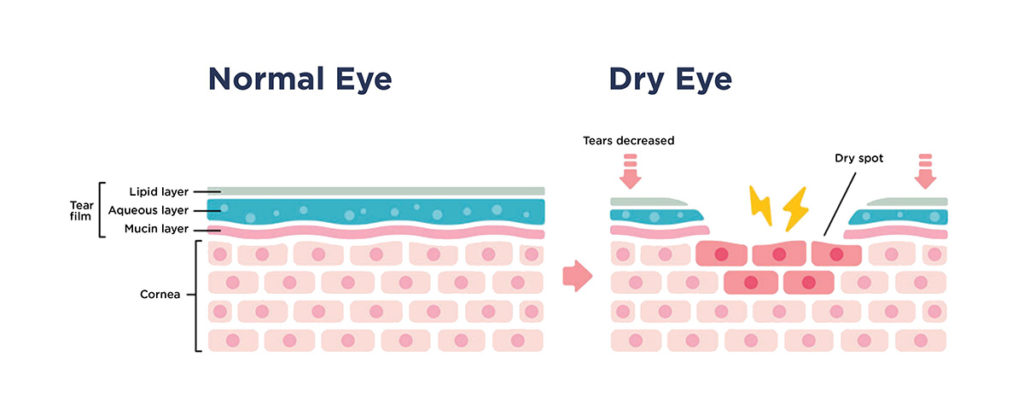What is Dry Eye?
Dry eye usually refers to a lack of moisture reaching the ocular surface, or the tears meant to reach the ocular surface evaporate too quickly. 65% of patients with dry eye symptoms have a condition called Meibomian Gland Dysfunction. These lubricating meibomian glands provide the protective oil layer meant to prevent tears from evaporating. With this condition, the glands can become obstructed and an inadequate amount of protective oil is present in your tears.
Factors such as the environment, aging, hormonal changes, medications, inadequate blinking, poor diet, and diseases like arthritis all play a significant role in reducing this moisture.
Learn moreTears are made up of three layers:
- Lipid (oil) layer: lubricates and prevents evaporation
- Aqueous (water) layer: nourishes and protects the cornea
- Mucin layer: adheres tears to the eye
Common Dry Eye Symptoms
- Dryness
- Discomfort and irritation
- Grittiness or feeling of a foreign body in the eye
- Burning or stinging sensation
- Tearing
- Redness
- Discharge
- Tiredness
- Itching
- Vision disturbance
- Sensitivity to light
Lifestyle impacts from Dry Eye
- Difficulty performing visual tasks, such as reading, using a computer, driving, and watching television
- Inability to wear contact lenses
- Constant use of eye drops
- Trouble being out in the sun
- Symptoms worsening as the day progresses
Underlying Causes of Dry Eye
Blepharitis: Bacteria on the skin and eyelashes can cause a condition known as blepharitis. Blepharitis is persistent and common inflammation of the eyelids. If left untreated, this condition may cause permanent damage to the natural glands of the eyelid meant to keep your eyes moist. Traditionally, this condition can be difficult to treat due to its recurrent nature.

Meibomian Gland Dysfunction: The meibomian glands of the upper and lower lids play one of the biggest roles in dry eye symptom management. These glands produce lipids to coat the tears and prevent them from evaporating. Studies show approximately 65% of dry eye symptoms are caused by dysfunction of these glands.
As we age, these glands can get obstructed with bacteria, cholesterol, debris, allergens, and makeup. A common treatment is hot compresses to help loosen the obstruction, however, it usually provides minimal relief.
Dry Eye Treatment Options
LipiFlow
Herzig Eye Institute was the first to provide the breakthrough treatment LipiFlow® and was designated the first TearScience® Centre of Excellence in North America. If you have chronic dry eye symptoms, there is a clinically-proven treatment with the potential to help you maintain a normal lifestyle by reducing the discomfort of dry eye.
With the advancement of technology, it is now possible to treat the root of dry eye symptoms by unblocking the meibomian glands.
The meibomian glands are the eyelid glands responsible for producing the necessary oils for the tear film. This treatment is called the LipiFlow® Thermal Pulsation System.
Opening the blocked eyelid glands allows the body to resume natural production of lipids (oils). The LipiFlow® treatment is offered at Herzig Eye Institute in a comfortable in-office setting. Most patients who have LipiFlow® feel relief of their symptoms within four weeks of treatment.
Microblepharoexfoliation
Blepharitis is a common problem, sometimes resulting in symptoms of itchy, red eyelids, eyelash crusting, sticky eyelids, burning, or gritty sensation in the eyes. If left untreated it may lead to increased symptoms of dry eye syndrome and make the eyes more prone to eyelid and eye infections.
Microblepharoexfoliation® (BlephEx) is a procedure to treat blepharitis. It is a medical treatment used by a doctor to gently exfoliate and safely and precisely remove debris and crusts around the eyelashes.
HYLO® Preservative-Free Tears
We were the first clinic in Canada to offer HYLO® Lubricating Eye Drops and HYLO® Gel. HYLO® is an ideal lubricant for patients who suffer from dry eye disease or have symptoms of dry eye following eye surgery. HYLO® is unique because it is preservative-free, phosphate-free, and provides intensive, long-lasting relief from dryness and irritation.
Preservatives can damage the cells of the eye surface and destroy the natural tear surface. Phosphate-based buffer systems can cause complications like water-insoluble calcium phosphate deposits in the cornea.
Developed by German scientists, HYLO®’s innovative multi-dose container is easy to use and designed to deliver 300 sterile doses of solution, one drop at a time. HYLO® is proven, safe, and well-established in European clinics.
CONTACT LENS INTOLERANCE
WHAT IS CONTACT LENS INTOLERANCE?
Contact lens intolerance affects many longtime contact lens wearers. After all the years of wearing contacts, the eye tires of the foreign body (contact lens) and starts to show signs of rejection.
SYMPTOMS OF CONTACT LENS INTOLERANCE
- Dry and itchy eyes earlier in the day
- Frustration with being at the mercy of your eyes
- Rationing your contact lens time
- A sense people are noticing you wearing your glasses more
TREATMENT OPTIONS FOR CONTACT LENS INTOLERANCE
The permanent solution to contact lens intolerance is a vision correction procedure. Herzig Eye Institute offers a range of High Definition Vision® solutions for people with less than perfect vision. In many cases you can spend the rest of your life never having to deal with contact lenses or prescription eyeglasses again!
Dry Eye Frequently Asked Questions
This content has been reviewed and approved by the surgeons at Herzig Eye Institute



